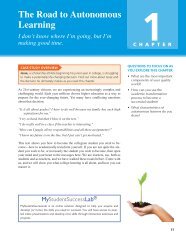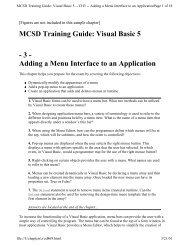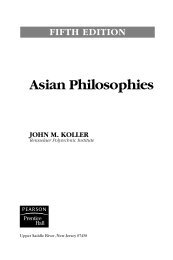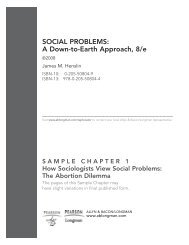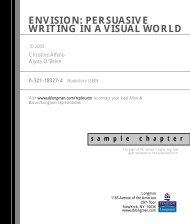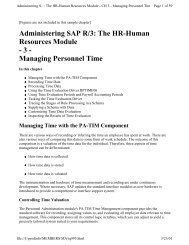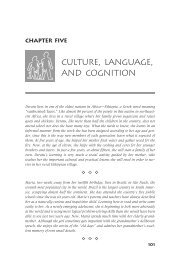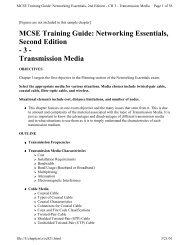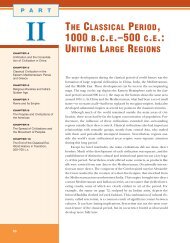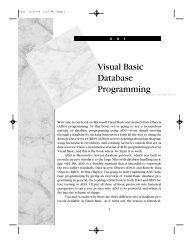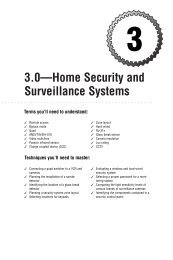Phonetic Transcription and Diacritics
Phonetic Transcription and Diacritics
Phonetic Transcription and Diacritics
You also want an ePaper? Increase the reach of your titles
YUMPU automatically turns print PDFs into web optimized ePapers that Google loves.
<strong>Phonetic</strong> <strong>Transcription</strong><br />
<strong>and</strong> <strong>Diacritics</strong><br />
LEARNING OBJECTIVES<br />
When you have fi nished this chapter, you should be able to:<br />
•<br />
•<br />
•<br />
•<br />
•<br />
•<br />
•<br />
Defi ne phonetic transcription <strong>and</strong> explain why it is a notational system.<br />
Describe how the International <strong>Phonetic</strong> Alphabet is used.<br />
Explain the value of transcription for speech-language therapists.<br />
Defi ne diacritics.<br />
Identify the diacritics used to delineate consonant sounds.<br />
Identify the diacritics used to mark vowels.<br />
Identify the diacritics used to mark stress, duration, <strong>and</strong> syllable boundaries.<br />
Virtually every book on articulatory-phonological<br />
disorders contains a brief discussion<br />
of phonetic transcription. In such a section,<br />
the symbols <strong>and</strong> diacritics of the International<br />
<strong>Phonetic</strong> Alphabet are listed together with a<br />
comment on the importance of accurate transcription<br />
for the assessment procedure. This<br />
underplays its importance, however; accurate<br />
transcription forms the basis for the diagnosis of<br />
articulatory-phonological impairments. If clinicians<br />
cannot correctly identify <strong>and</strong> transcribe<br />
the productions of their clients, their therapy<br />
will not be as goal directed as it should be.<br />
Nevertheless, in training <strong>and</strong> in clinical<br />
practice, phonetic transcription seems to be<br />
3<br />
one of the most neglected areas of study. Although<br />
transcription skills are as indispensable<br />
as they are diffi cult to master, the chance<br />
to learn them is often limited to one undergraduate<br />
course. This meager knowledge base<br />
is seldom systematically exp<strong>and</strong>ed or revisited<br />
in other courses or in most clinical experiences.<br />
Many practicing clinicians simply do<br />
not feel comfortable with phonetic transcription<br />
<strong>and</strong> therefore, unfortunately, use it as infrequently<br />
as possible.<br />
<strong>Phonetic</strong> transcription is more than just<br />
transposing perceived sounds into “strange”<br />
symbols; it is above all a process of fi ne- tuning<br />
one’s auditory perception for the purpose of<br />
37
38 CHAPTER 3<br />
successful clinical intervention. Perceptual<br />
skills improve with systematic efforts to listen<br />
carefully to, <strong>and</strong> to differentiate accurately<br />
between, subtle changes in sound quality. Although<br />
this is not a workbook on phonetic<br />
transcription (this section does not offer<br />
nearly enough information for such a course),<br />
phonetic transcription will be emphasized<br />
<strong>and</strong> treated in considerably more detail than is<br />
usually the case in textbooks on articulatoryphonological<br />
disorders.<br />
The fi rst goal of this chapter is to introduce<br />
the International <strong>Phonetic</strong> Alphabet as the notational<br />
system used to document norm productions<br />
of vowels <strong>and</strong> consonants of General<br />
American English. However, the transcription<br />
of disordered speech requires more than that.<br />
It needs additional signs, diacritical marks,<br />
that can be added to basic transcription symbols<br />
to indicate aberrant sound values. They<br />
provide a means of documenting irregular<br />
articulatory events. Therefore, this chapter’s<br />
second goal is to present <strong>and</strong> discuss some of<br />
the more common diacritical markers. Clinical<br />
comments are included to exemplify the<br />
use of these diacritics. The third goal of this<br />
chapter is to examine the clinical implications<br />
of phonetic transcription, including the use of<br />
diacritics. Examples are provided to demonstrate<br />
how phonetic transcription can be used<br />
in the assessment process. Familiarity with,<br />
<strong>and</strong> the proper use of, phonetic transcription<br />
is seen as an invaluable tool for the diagnosis<br />
<strong>and</strong> treatment of articulatory- phonological<br />
impairments.<br />
PHONETIC TRANSCRIPTION<br />
AS A NOTATIONAL SYSTEM<br />
Speech is a fl eeting event, existing for only the<br />
shortest period of time—so short, in fact, that<br />
if we don’t employ artifi cial means to preserve<br />
speech, we couldn’t prove that it had ever ex-<br />
isted, even immediately after the event. Historically,<br />
all writing systems were invented to<br />
make speech events last longer, to preserve<br />
them.<br />
Traditional writing systems do a great job<br />
in preserving what has been said, but they fall<br />
grossly short in indicating how it has been<br />
said, even though this can be just as important.<br />
For example, a speech pathologist needs<br />
to document the details of a child’s aberrant<br />
sound realization. There are no letters in our<br />
alphabet for laterally produced s-sounds, for<br />
instance. Professionals clearly need more information<br />
about how a specifi c speech event<br />
has been executed than about what has been<br />
said. For these special purposes, all traditional<br />
writing systems are useless. Special ones had to<br />
be invented to serve these needs. <strong>Phonetic</strong> transcription<br />
systems were devised in order to document<br />
real actualizations of speech events.<br />
Today, the frequently revised International<br />
<strong>Phonetic</strong> Alphabet (IPA) is probably the<br />
most widely accepted transcription system in<br />
the world (see Figure 3.1). The International<br />
<strong>Phonetic</strong> Association, founded in 1886, published<br />
the fi rst IPA in 1888. The International<br />
<strong>Phonetic</strong> Alphabet offers a one-to-one correspondence<br />
between phoneme realizations <strong>and</strong><br />
sound symbols. However, at the same time,<br />
many additional signs can be used to identify<br />
modifi cations in the original production. Generally,<br />
the IPA serves the professional interests<br />
of speech-language pathologists well. Its symbols<br />
capture much of what we are interested<br />
in. Occasionally, one may be forced to add to<br />
the inventory of available symbols in order<br />
to characterize an aberrant production. That,<br />
though, is to be expected, because phonetic<br />
transcription systems are typically designed<br />
to transfer st<strong>and</strong>ard (but highly impermanent)<br />
speech events adequately into (more<br />
durable) readable signs. In aberrant speech,<br />
just about anything can happen, <strong>and</strong> this may<br />
well necessitate additional characters for un-
Figure 3.1 The International <strong>Phonetic</strong> Alphabet (revised to 2005). Copyright 2005 by the<br />
International <strong>Phonetic</strong> Association.<br />
39
40 CHAPTER 3<br />
usual articulatory events. If such an additional<br />
characterization becomes necessary, the specifi<br />
c phonetic value of any added sign must, of<br />
course, be described precisely <strong>and</strong> in detail. If<br />
other professionals cannot reliably “read” the<br />
transcribed materials, they cannot accurately<br />
retransform the symbols into the original phonetic<br />
events; that is, they still won’t know how<br />
the sound was actualized. Under such circumstances,<br />
any phonetic transcription becomes<br />
pointless.<br />
<strong>Phonetic</strong> transcription is a purely descriptive<br />
enterprise. It is nothing but the “spelling<br />
out” of an actual speech event by means<br />
of special symbols invented to represent the<br />
sounds of the utterance in question.<br />
Occasionally, beginning transcription materials<br />
consist of lists of orthographically presented<br />
words (book, table, snail, <strong>and</strong> so on) that<br />
students then have to transfer into phonetic<br />
symbols. Such a practice can be misleading. It<br />
supports the mistaken notion that there is a<br />
prescriptive part to phonetic transcription, that<br />
it provides some guiding principle about how<br />
words are supposed to be pronounced. This is<br />
also suggested by dictionaries: Each entry tells<br />
the reader how to spell a word correctly, <strong>and</strong><br />
the following symbols indicate how the word<br />
“should be” pronounced. There is, of course,<br />
nothing wrong with spelling out how words<br />
are commonly pronounced, but any jump<br />
from how they are pronounced to how they<br />
should be <strong>and</strong> are pronounced has nothing to<br />
do with the idea behind, <strong>and</strong> practice of, phonetic<br />
transcription.<br />
WHY USE PHONETIC TRANSCRIPTION?<br />
Accurate phonetic transcription is an indispensable<br />
clinical tool for speech-language pathologists.<br />
That is why it has to be taken so<br />
seriously, especially when dealing with the<br />
assessment <strong>and</strong> remediation of impaired ar-<br />
ticulation <strong>and</strong> phonology. Without a reliable<br />
record of how a child or adult realized a particular<br />
speech sound, we simply do not have<br />
enough information for goal-directed intervention.<br />
<strong>Phonetic</strong> transcription provides a<br />
reasonably accurate written record of what<br />
was said <strong>and</strong> what it sounded like.<br />
Admittedly, phonetic transcription is<br />
somewhat troublesome <strong>and</strong> time consuming.<br />
In addition, it certainly has its own problems.<br />
Some rules have to be strictly observed<br />
in order to overcome these problems. The fi rst<br />
thing any aspiring transcriber has to underst<strong>and</strong><br />
is that the human ear is not a microphone.<br />
We are unable to receive only; we must<br />
always perceive; that is, people automatically<br />
judge <strong>and</strong> interpret incoming acoustic signals<br />
based on their experience with those signals.<br />
In respect to spoken language, this means that<br />
when listening to the incoming acoustic signal,<br />
the listener unwillingly “distorts” it in<br />
the direction of former experiences, including<br />
how the listener would have produced it.<br />
This “built-in” tendency is the greatest danger<br />
to any serious transcription effort. Any higher<br />
degree of accuracy achieved while listening to<br />
<strong>and</strong> then describing the how of its production<br />
is very diffi cult to attain if perceptual biases<br />
rule transcription efforts. To overcome the tendency<br />
to “interpret” what was heard requires<br />
considerable goodwill, patience, <strong>and</strong> special<br />
training.<br />
There are several other problems that must<br />
be considered when using phonetic transcription.<br />
For example, many circumstances can af-<br />
fect our transcription,<br />
such as the age of the client<br />
or an unusual vocal<br />
quality. Other factors may<br />
produce large variations<br />
in the inter- <strong>and</strong> intrajudge<br />
reliability of transcriptions,<br />
including the<br />
intelligibility of the client<br />
Interjudge reliability<br />
denotes the percentage<br />
of agreement<br />
between two or more<br />
people’s transcriptions.<br />
Intrajudge<br />
reliability is how well<br />
a person agrees with<br />
his or her own former<br />
transcription.
(Shriberg <strong>and</strong> Lof, 1991), the position of the<br />
sound in the word (Philips <strong>and</strong> Bzoch, 1969;<br />
Shriberg <strong>and</strong> Lof, 1991), <strong>and</strong> whether narrow<br />
or broad transcription is used (Shriberg <strong>and</strong><br />
Lof, 1991). Shriberg <strong>and</strong> Kent (2003) provide<br />
an excellent overview of the sources of variation<br />
<strong>and</strong> the factors that affect the reliability<br />
of phonetic transcription. These problems are<br />
very real, <strong>and</strong> caution must be exercised when<br />
using phonetic transcription. On the other<br />
h<strong>and</strong>, we cannot simply disregard transcription<br />
because of its inherent problems or use<br />
a private system of noting sound realizations.<br />
Instead, the importance of developing good,<br />
reliable transcription skills should be stressed.<br />
They will prove to be an invaluable resource in<br />
the assessment <strong>and</strong> treatment of articulatoryphonological<br />
disorders.<br />
DIACRITICS<br />
<strong>Diacritics</strong> are marks added to sound transcription<br />
symbols in order to give them a particular<br />
phonetic value. The set of basic phonetic transcription<br />
symbols represents language-specifi c<br />
typical productions. Because speech-language<br />
pathologists deal mostly with aberrant articulatory<br />
events, it follows that diacritical<br />
markers are of special importance when characterizing<br />
the speech of their clients. <strong>Diacritics</strong><br />
are needed to note the clients’ deviant sound<br />
qualities.<br />
Numerous diacritics are noted in Figure 3.1.<br />
Although these diacritics have functioned fairly<br />
effectively, extensions to the IPA (extIPA) were<br />
diacritics developed specifi cally to address the<br />
transcription of disordered speech. The extIPA<br />
symbols, fi rst published in 1990, were revised<br />
in 1997. Figure 3.2 is a list of the extIPA symbols.<br />
The following discussion on diacritics includes<br />
only those frequently used by clinicians.<br />
Readers should refer to Figures 3.1 <strong>and</strong> 3.2 for<br />
special transcription needs as they develop.<br />
PHONETIC TRANSCRIPTION AND DIACRITICS 41<br />
<strong>Diacritics</strong> Used with Consonants<br />
Changes in Place of Articulation for Consonants.<br />
These symbols describe deviations from normal<br />
tongue placement for consonants.<br />
Dentalization. Dentalization refers to an articulatory<br />
variation in which the tongue approaches<br />
the upper incisors. It is marked by<br />
[ � ] placed under the IPA symbol. For example,<br />
the symbol [d] st<strong>and</strong>s for a coronalalveolar<br />
voiced stop. A dentalized realization<br />
results when a child places the tip of the<br />
tongue not against the alveolar ridge, as the<br />
IPA symbol indicates, but against the inside of<br />
the upper incisors. A dentalized realization is<br />
transcribed as<br />
[d� ] = dentalized [d]<br />
[d� ] occurs quite often as the result of coarticulation.<br />
Compare [d]-productions in the<br />
words widow <strong>and</strong> width. The articulatory infl uence<br />
of the following [θ], an addental or even<br />
interdental sound, will probably “dentalize”<br />
normally alveolar [d] realizations. Dentalized<br />
s-sounds, [s�] <strong>and</strong> [z�], frequently occur in the<br />
speech of children (Van Riper, 1978; Weiss,<br />
Gordon, <strong>and</strong> Lillywhite, 1987).<br />
Palatalization. Another modifi cation of consonant<br />
articulation is palatalization. Only sounds<br />
for which the palate is not the place of articulation<br />
can be palatalized. Therefore, palatalization<br />
can occur with sounds that have a place<br />
of articulation anterior or posterior to the hard<br />
palate region. If the place of articulation is the<br />
alveolar ridge or the upper incisors, palatalization<br />
occurs if the anterior portions of the<br />
tongue approach prepalatal or mediopalatal<br />
portions of the palate, that is, when organ <strong>and</strong><br />
place of the production are articulated somewhat<br />
posteriorly. For velar consonants, palatalization<br />
indicates the movement of the place
Figure 3.2 ExtIPA Symbols for Disordered Speech (revised to 1997). Copyright 2002 by<br />
the International Clinical <strong>Phonetic</strong>s <strong>and</strong> Linguistics Association. Reprinted with permission.<br />
42
<strong>and</strong> organ of articulation in the direction of<br />
the palate, to a more anterior articulation. Palatalization<br />
causes a typical change in the quality<br />
of the sound(s) in question. The diacritical<br />
mark for palatalization is a superscript j added<br />
to the right of the basic IPA symbol:<br />
[s�] = palatalized [s]<br />
[t�] = palatalized [t]<br />
Velarization. Velarization refers to the posterior<br />
movement of the tongue placement (in<br />
the direction of the velum) for palatal sounds.<br />
The diacritical mark for velarization is a superscript<br />
γ placed to the right of the IPA symbol.<br />
Thus [t�] is a velarized [t]. An exception is the<br />
so-called dark [l], which in General American<br />
English is usually heard in word-fi nal positions,<br />
for example in pull or shawl; also as a<br />
syllabic, such as in little or bottle; preceding a<br />
consonant, exemplifi ed by salt or build; <strong>and</strong><br />
following high-back vowels [u] (loop) or [υ]<br />
(look) (Bronstein, 1960; Carrell <strong>and</strong> Tiffany,<br />
1960; Small, 2005). The velarization in these<br />
The so-called dark<br />
<strong>and</strong> light l-sounds<br />
are discussed in more<br />
detail in Chapter 8.<br />
cases is often so prominent<br />
that even main phonetic<br />
characteristics of<br />
[l], the articulation of the<br />
tongue tip against the alveolar ridge, are sometimes<br />
no longer present. In such a case, the<br />
velarization actually replaces the typical apicoalveolar<br />
l-articulation. The velarized production<br />
is an allophonic variation of [l]. Velarized<br />
[l]-productions are transcribed [�]:<br />
[fu�] = velarized [l]-sound<br />
Lateralization. [l] is the only lateral in General<br />
American English. It cannot be lateralized<br />
because it is a lateral already. If during any<br />
consonant production other than [l] air is released<br />
laterally, we speak of lateralization. Not<br />
too seldom, [s] becomes lateralized. Articula-<br />
PHONETIC TRANSCRIPTION AND DIACRITICS 43<br />
tions of [s] <strong>and</strong> [z] require a highly accurate<br />
placement of frontal parts of the tongue approximating<br />
the alveolar ridge. This precarious<br />
position must be maintained throughout the<br />
entire sound duration, a motorically diffi cult<br />
task, especially for young children. To make<br />
things easier, children sometimes establish direct<br />
contact between the organ <strong>and</strong> place of<br />
articulation. Under these circumstances, the<br />
airstream cannot, of course, escape centrally<br />
any longer. In an attempt to maintain the fricative<br />
effect of [s], the child now releases the air<br />
laterally into the cheeks. The result is a conspicuous<br />
[s] variation, a lateral lisp. Lateralization<br />
is considered a primary articulation; the<br />
resulting sound can be categorized as an apicoalveolar<br />
lateral fricative. According to the IPA,<br />
[�] is the voiceless apico-alveolar fricative, <strong>and</strong><br />
[�] is its voiced counterpart.<br />
[sip] → [�ip] = a lateralized [s]<br />
[zip] → [�ip] = a lateralized [z]<br />
The extIPA symbols also provide symbols to distinguish<br />
between productions that demonstrate<br />
both lateral <strong>and</strong> central airfl ow (as opposed to<br />
just lateral). The symbols for those are<br />
[su] → [ls u] = a voiceless alveolar fricative<br />
with lateral <strong>and</strong> central airfl ow<br />
[zu] → [lz u] = a voiced alveolar fricative with<br />
lateral <strong>and</strong> central airfl ow<br />
CLINICAL COMMENTS<br />
Dentalized, palatalized, <strong>and</strong> lateralized [s] realizations<br />
are frequent distortions noted in children. In some<br />
children, the dentalized [s�] may co-occur with a “th”<br />
for “s” substitution ([s] → [θ]), as in the following<br />
production:<br />
“Santa Claus” [θ�n tə klɑs�] for [s�n tə klɑz]<br />
The too-fronted tongue position of the child’s<br />
[s]-productions may fl uctuate slightly, so that it is
44 CHAPTER 3<br />
perceived at times as [ s� ], at other times as [θ]. It is<br />
interesting to note, however, that certain children<br />
may also use this dichotomy systematically: [θ] may<br />
be realized initiating words or syllables, while [ s� ] is<br />
produced terminating words or syllables, for example.<br />
Such a possibility should be considered in our<br />
assessment.<br />
Differentiating between dentalized, palatalized,<br />
<strong>and</strong> lateralized [s]-productions may seem diffi cult<br />
at fi rst. However, there are clear perceptual qualities<br />
that distinguish the three forms of [s] actualization.<br />
Dentalized [s]-sounds, [ s� ], have a “dull” quality; they<br />
lack the sharp, high-frequency characteristic of typical<br />
[s]- productions. On the other h<strong>and</strong>, lateralized [s]sounds,<br />
[�], have a distinct noise component to them<br />
that is typically as disagreeable as it is conspicuous.<br />
Palatalized [s] variations, [s� ], approach perceptually a<br />
[ ʃ ] quality. Palatalization of [s] is marked by the anterior<br />
portions of the tongue approaching parts of the<br />
palate resulting in a somewhat posterior placement<br />
of the organ <strong>and</strong> place of articulation. Comparing the<br />
production features of [s] to [ ʃ ], one notes that [ ʃ ]<br />
realizations also require a more posteriorly placed organ<br />
<strong>and</strong> place of articulation (apico-alveolar [s] versus<br />
coronal-prepalatal [ ʃ ]).<br />
Voice Symbols<br />
Devoicing of Voiced Consonants. Under normal<br />
circumstances, vowels <strong>and</strong> more than half of<br />
our consonants are voiced. If these sounds become<br />
devoiced in a speech sample, it needs to<br />
be marked. In cases of total devoicing, the IPA<br />
symbol for the voiceless counterpart of the<br />
voiced sound, its unvoiced cognate, is usually<br />
indicated:<br />
[ ʃus] for “shoes”<br />
[brεt] for “bread”<br />
Partial Devoicing. Often, however, the sound<br />
in question is only partially devoiced. The diacritic<br />
for partial devoicing is a small circle in<br />
parentheses placed under the sound symbol:<br />
[ ʃuz ���]<br />
[brεd���]<br />
The extIPA also differentiates initial devoicing<br />
[ �� ] <strong>and</strong> fi nal devoicing [ �� ].<br />
Voicing of Voiceless Consonants. Voiceless consonants<br />
may also be voiced, especially if they<br />
occur between two vowels. A casual pronunciation<br />
of eighteen might serve as an example.<br />
If voiceless consonants become totally voiced,<br />
the segment is transcribed with the respective<br />
symbol:<br />
[e I tin] → [e I din]<br />
Partial Voicing. If voiceless consonants become<br />
partially voiced, the diacritical mark is<br />
a lowercase v in parentheses under the respective<br />
sound symbol:<br />
[ei���in] t for “eighteen”<br />
Initial <strong>and</strong> fi nal partial voicing are [��] <strong>and</strong> [��],<br />
respectively.<br />
CLINICAL COMMENTS<br />
Partial voicing <strong>and</strong> devoicing are diffi cult to discern<br />
<strong>and</strong> to transcribe correctly. The fi rst impression of<br />
transcribers is often some minor qualitative variance—<br />
the sound is somehow “off.” Such a fi rst impression is<br />
usually a good reason to focus subsequently on the<br />
voicing–devoicing opposition. This two-step procedure<br />
makes it easier to arrive at the diffi cult judgment:<br />
partially voiced or partially devoiced.<br />
Also, in General American English, there is a tendency<br />
to devoice (or partially devoice) fi nal consonants.<br />
The following are examples from Daniel, age<br />
4;7.<br />
“stove” [stoυv] → [stoυf] total devoicing<br />
“slide” [slaid] → [slaid��] partial devoicing<br />
“fl ag” [fl �g] → [fl �g��] partial devoicing<br />
“nose” [noυz] → [noυs] total devoicing<br />
The general devoicing tendency in fi nal positions suggests<br />
that realizations like these should probably not<br />
be considered aberrant productions.
Aspiration <strong>and</strong> Nonaspiration of Stop-Plosives.<br />
Stop-plosives (as well as other consonants)<br />
are often described according to two parameters:<br />
fortis <strong>and</strong> lenis. Fortis refers to relatively<br />
more articulatory effort, whereas lenis refers<br />
to comparatively less. Most voiceless sounds<br />
are realized as fortis consonants, whereas<br />
voiced sounds are usually articulated as lenis<br />
productions. (One can note the increased articulatory<br />
effort on the level of air pressure by<br />
contrasting [t] <strong>and</strong> [d] with a h<strong>and</strong> in front of<br />
the mouth.) The sudden release of the articulatory<br />
effort in fortis stop-plosives leads typically<br />
to aspiration. This aspiration is noted<br />
by using a small superscript h following the<br />
voiceless stop-plosive sound:<br />
“table” [t h e i bəl]<br />
Stop-plosives, which are normally aspirated,<br />
are not marked unless the aspiration is<br />
excessive.<br />
Voiceless stop-plosives that are typically<br />
aspirated may be produced without this fortis<br />
aspiration. In this case, the diacritic for unaspirated<br />
stops, [�], could be added.<br />
“pie” [p�a i ]<br />
This example indicates that a normally aspirated<br />
[p] has occurred without aspiration.<br />
CLINICAL COMMENTS<br />
Voiceless stop-plosives are usually aspirated at the beginning<br />
of words; however, they are not aspirated in<br />
consonant clusters. Word-fi nal aspiration is variable<br />
(Edwards, 2003).<br />
Unreleased Stop-Plosives. Stop-plosives can be<br />
modifi ed in yet another manner. Unreleased<br />
consonants result when the articulatory<br />
closure is maintained <strong>and</strong> not—as usual—<br />
PHONETIC TRANSCRIPTION AND DIACRITICS 45<br />
released. Although voiceless unreleased stops<br />
are more obvious because of their loss of aspiration,<br />
voiced stops can be unreleased as<br />
well. Unreleased stops typically occur at the<br />
end of an utterance or at the end of one-word<br />
responses. To indicate an unreleased articulation,<br />
the diacritical mark [�] is added:<br />
Boy, was it hot.<br />
[bɔi w�z it hɑt�]<br />
CLINICAL COMMENTS<br />
Unreleased consonants should be noted during the simultaneous<br />
transcription of a client’s speech. Just listening<br />
to <strong>and</strong> transcribing from tape recordings can<br />
be misleading because, when taped, unreleased consonants<br />
can sound similar to consonant omissions.<br />
Confusing this production variation with a fi nal consonant<br />
deletion could lead to an inaccurate diagnosis.<br />
During live transcriptions, we can hear <strong>and</strong> at least<br />
partially see the actual articulation. This provides a<br />
much better basis for our judgment: unreleased consonant<br />
production or consonant deletion.<br />
The following transcriptions come from an articulation<br />
test of Billy, age 4;3:<br />
“cup” [k�p] → [t�p�]<br />
“music” [mjuzik] → [mudik�]<br />
“book” [bυk] → [bυk�]<br />
“feet” [fi t] → [fi t�]<br />
“watch” [wɑtʃ ] → [wɑt�]<br />
“s<strong>and</strong>wich” [s�nwitʃ ] → [g�mit�]<br />
Unreleased consonants seldom warrant therapeutic<br />
intervention. Billy’s case was different. Coming in addition<br />
to his many articulation errors, they contributed<br />
substantially to a decrease in his intelligibility.<br />
Syllabic Consonants. Unstressed syllables easily<br />
become reduced syllables. This means that<br />
their vowel nucleus practically disappears.<br />
If the vowel nucleus is reduced, the following<br />
consonant becomes a syllabic; that is, it<br />
becomes the peak of that syllable. This is especially<br />
the case in unstressed fi nal syllables
46 CHAPTER 3<br />
when a nasal or the lateral [l] follows the preceding<br />
vowel (Heffner, 1975). The proper diacritic<br />
mark for such an occurrence is a straight<br />
line directly under the syllabic consonant.<br />
fiʃiŋ → fiʃən → fiʃn�<br />
CLINICAL COMMENTS<br />
In spontaneous speech, adults often reduce the unstressed<br />
fi nal syllable, as in the following example:<br />
He broke the bottle.<br />
[hi broυk ðə bɑtl� ]<br />
In spontaneous speech, <strong>and</strong> often during an articulation<br />
test, children will also demonstrate the use of syllabics.<br />
For example:<br />
“little” [litl� ]<br />
“scratching” [skr� tʃn� ]<br />
The boy is fi shing; he has a fi shing pole.<br />
[ðə� bɔ i iz � fiʃn� hi h�z ə � fiʃn� po υ l]<br />
While such syllabics, obviously, need to be noted <strong>and</strong><br />
transcribed, they are considered norm realizations.<br />
Labialization/Nonlabialization of Consonants.<br />
Consonants, with the exception of [ ʃ ] <strong>and</strong><br />
[w], are typically unrounded. Lip rounding<br />
is a production feature of both of these consonants.<br />
If a normally unrounded consonant<br />
is produced with lip rounding, this is referred<br />
to as labializing the sound in question. When<br />
the [ ʃ ] is produced without lip rounding, this<br />
is a nonlabialized production. The diacritic for<br />
labialized consonants is a superscript w placed<br />
to the right of the symbol in question. The<br />
diacritic for labial spreading ↔ is placed under<br />
the symbol in question to indicate nonlabialization.<br />
Labialized consonants can be the<br />
result of assimilation processes, as in the following<br />
example:<br />
“soup” [s �up] = labialized [s]<br />
Labialization of normally unrounded consonants<br />
due to assimilation is noted, but it is not<br />
considered a speech sound problem. On the<br />
other h<strong>and</strong>, [ ʃ ] is usually produced with at least<br />
some degree of lip rounding. The following example<br />
indicates [ ʃ ] without lip rounding:<br />
“ship” [ ʃ ↔ ip] = nonlabialized [ ʃ ]<br />
Unrounded [ ʃ ] realizations can also be due<br />
to assimilation; however, there are children<br />
who unround [ ʃ ] in all contexts. This<br />
should be noted <strong>and</strong> is considered an aberrant<br />
production.<br />
CLINICAL COMMENTS<br />
Rounded [s]- <strong>and</strong> unrounded [ ʃ ]-sounds are frequent<br />
sibilant realizations of children. These may be aberrant<br />
productions or context-based assimilation processes.<br />
The following is an excerpt from a transcription of<br />
Matt, age 4;6:<br />
The boy is swinging really high.<br />
[ðə bɔi iz s�wiŋən rili hai ]<br />
My mommy made vegetable soup.<br />
[mai mɑmi meid vεdʒəbəl s�up]<br />
In addition to Matt’s unorthodox pronunciation of<br />
vegetable, we note that his [s]-sounds are rounded. In<br />
the given context, they may be just assimilation processes<br />
regressively infl uenced by the rounding of the<br />
following [w] or [u].<br />
This does not seem to be the case in Chris’s transcription,<br />
based on an articulation test <strong>and</strong> a spontaneous<br />
speech sample.<br />
“fi sh” [fiʃ] → [fiʃ ]<br />
↔<br />
“watch” [wɑtʃ ] → [wɑʃ ]<br />
↔<br />
“chicken” [tʃ ikən] → [ ʃ ikən]<br />
↔ ↔<br />
“shovel” [ ʃ �vəl] → [ ʃ �vəl]<br />
↔ ↔<br />
At lunch I ate a peanut butter s<strong>and</strong>wich.<br />
[�t l�nʃ ↔ a i e i t ə pinət b�t� ʃ ↔ �niʃ ↔ ]<br />
I wish I had some new tennis shoes,<br />
like Michael Jordan.<br />
[a i wiʃ ↔ a i h�d s�m nu tεnəʃ ↔ uz la i k ma i kəl ʃ ↔ ordən]
Chris, in contrast to Matt, unrounds his “sh”-sounds<br />
even when they precede a rounded vowel, as in the<br />
word shoes. He also occasionally uses [ ʃ ] for [s]- <strong>and</strong><br />
[tʃ]-sounds.<br />
Derhotacization. Derhotacization is the loss<br />
of r-coloring for the consonant [r] <strong>and</strong> the<br />
central vowels with r-coloring, [�] <strong>and</strong> [�].<br />
Derhotacized central vowels are transcribed as<br />
[�] <strong>and</strong> [ə]. However, [r], as in rabbit, can lose<br />
its characteristic r-coloring as well. Children<br />
often substitute a [w] for this sound. Another<br />
possibility is the [ʋ], which is a voiced labiodental<br />
approximant. The [ʋ] sound lacks the<br />
high-back tongue position of [w], a labio- velar<br />
approximant; however, comparable to the [w],<br />
[ʋ] demonstrates a lack of r-coloring.<br />
<strong>Diacritics</strong> Used with Vowels<br />
Rounding/Unrounding of Vowels. There are<br />
vowels that are normally rounded <strong>and</strong> others<br />
that are normally unrounded—[u] versus [i],<br />
for example. The rounding or unrounding of<br />
the lips is an important feature of vowel realizations.<br />
However, for several reasons, some<br />
clients may delete or inappropriately add these<br />
characteristics. This results in a distortion of<br />
the respective sound quality. The IPA system<br />
offers two symbols to indicate rounding <strong>and</strong><br />
unrounding of vowels. The signs are placed<br />
directly under the vowel symbol in question<br />
<strong>and</strong> consist of a small c-type notation, which<br />
indicates unrounding (or less rounding than<br />
is considered normal) when open to the right.<br />
When this c is inverted, creating an opening<br />
to the left, it denotes rounding (or more<br />
rounding than is normally the case):<br />
[u� ] = unrounded [u]<br />
[ε� ] = rounded [ε]<br />
Changes in Tongue Placement for Vowels. Deviations<br />
in tongue positioning affect vowel<br />
PHONETIC TRANSCRIPTION AND DIACRITICS 47<br />
as well as consonant articulations. Different<br />
vowel qualities are established essentially by<br />
different sizes <strong>and</strong> forms of the vocal tract.<br />
Two main factors determining these sizes <strong>and</strong><br />
forms pertain to the location of the raised<br />
portion of the tongue (front <strong>and</strong> back dimensions)<br />
<strong>and</strong> to the extent to which the tongue is<br />
raised in the direction of the hard or soft palate<br />
(high <strong>and</strong> low dimensions).<br />
Raised/Lowered Tongue Position. The IPA system<br />
offers a set of diacritics that signals the<br />
direction of tongue heights on the vertical<br />
plane leading to deviations from norm vowel<br />
productions. The diacritic [�] under the vowel<br />
symbol marks a lower elevation, whereas the<br />
diacritic [�] under the vowel marks a higher<br />
elevation of the tongue than is normally the<br />
case for the production of the vowel in question.<br />
For example,<br />
[s i� t]<br />
would state that the high-front elevation of<br />
the tongue for st<strong>and</strong>ard [i] articulation has<br />
not been reached in this realization; that is,<br />
the tongue articulation was lower than normal,<br />
resulting in a perceptible off-quality for<br />
[i]. Trying to describe our auditory impression<br />
of this sound, we would say that it shifted in<br />
the direction of (but not reaching) the sound<br />
quality of [e].<br />
Similarly, the transcription<br />
[b i� t]<br />
would indicate a higher-than-normal elevation<br />
of the tongue for [i], resulting in a quality<br />
that approaches [i] characteristics.<br />
The same principle applies to all vowels.<br />
A question that logically follows is whether<br />
it makes a difference which symbol we use if<br />
the vowel is somewhere in between two qualities.<br />
In other words, do a raised [e] ([e� ]), <strong>and</strong>
48 CHAPTER 3<br />
Think of the symbol as a pointer with its base<br />
the top of the T-type notation. If the pointer<br />
projects down [�], the tongue has been lowered;<br />
if it points up [�], the tongue has been raised.<br />
a lowered [i] ([i�]) signify the same vowel quality?<br />
The answer is no. Therefore, in our previous<br />
example, one has to make a decision as to<br />
whether this vowel realization sounded more<br />
like an [e]- or an [i]-type vowel. Based on the<br />
transcriber’s auditory perception, the basic<br />
vowel quality must fi rst be chosen, <strong>and</strong> then<br />
the modifying diacritic mark should be added<br />
to it.<br />
Advanced/Retracted Tongue Position. There<br />
are also diacritics signaling tongue variations<br />
on the horizontal plane that lead to deviations<br />
from norm productions. They indicate a<br />
tongue position that is too far forward or too<br />
far back for a norm production of the vowel<br />
in question. The diacritic for vowels produced<br />
with a tongue elevation more advanced than<br />
usual is [ � ]. More retracted protrusions are<br />
marked by the diacritic [ � ]. Both are placed under<br />
the vowel symbol: [ε�] , for example.<br />
CLINICAL COMMENTS<br />
Changes in the position of the tongue for vowel realizations<br />
are often perceptually diffi cult to target. Although<br />
transcribers are aware that the vowel quality is<br />
“off,” they may not be sure in which direction. If the<br />
tongue has been lowered or raised, the vowel quality<br />
will sound somehow similar to the neighboring vowel<br />
on the vertical plane of the vowel quadrilateral. Thus,<br />
a lowered [ε] will have a certain [�] quality, or a raised<br />
[υ] will approach a [u]. The best reference source in<br />
these cases is the vowel quadrilateral. However, this<br />
is not as simple if the tongue movements pertain to<br />
the horizontal plane—that is, to a tongue position too<br />
advanced or retracted. One point of reference is that<br />
front vowels that demonstrate a retracted tongue position<br />
<strong>and</strong> back vowels that demonstrate too forward a<br />
tongue position sound somewhat “centralized”—that<br />
is, their distinct qualities appear reduced. Therefore,<br />
although the vowel can still be identifi ed as the respective<br />
front or back vowel, it approaches a [�]-type<br />
quality.<br />
Nasality Symbols. During the production<br />
of most General American English speech<br />
sounds, the velum is elevated to block the escape<br />
of the expiratory air through the nasal<br />
cavity. There is only one exception to this rule:<br />
the nasals. This is what—quite correctly—the<br />
textbooks tell us. However, in reality, the conditions<br />
are not always so clear-cut. If a nasal<br />
follows a vowel, for example, nasality often<br />
seeps into the vowel segment; the preceding<br />
vowel becomes nasalized:<br />
[t�n] → [t�˜n]<br />
As long as the nasality doesn’t overstep<br />
the boundary line of natural assimilatory processes,<br />
this nasality remains unmarked. Speakers<br />
<strong>and</strong> listeners perceive these variations as<br />
normal. However, if the nasality is perceived<br />
as being excessive, or hypernasal, we need to<br />
place the “tilde” (which you may have encountered<br />
in Spanish language classes) over<br />
the respective sound(s). As speech-language<br />
specialists, we encounter hypernasality prominently<br />
in the speech of clients with dysarthria<br />
<strong>and</strong> cleft palates.<br />
Denasality is also encountered in the<br />
speech of our clients. The symbol for denasality<br />
is the tilde with a slash through it, placed<br />
above the nasal consonant:<br />
ni → ˜�ni<br />
This symbol refers to a reduction of nasal quality.<br />
Only nasal consonants can be denasalized.<br />
If nasal consonants are perceived as having a
total lack of nasal quality (having a completely<br />
oral quality), then the symbol for the resulting<br />
homorganic voiced stop is used:<br />
ni → di<br />
CLINICAL COMMENTS<br />
One of the characteristics of African American dialect<br />
is the total regressive assimilation of postvocalic nasals<br />
(e.g., Haynes <strong>and</strong> Moran, 1989; Wolfram, 1986).<br />
The assimilation process is regressive in that the nasal<br />
following the vowel changes the characteristic of<br />
the preceding vowel into a nasalized vowel. It is considered<br />
a total assimilation process because the postvocalic<br />
nasal consonant is totally gone. The following<br />
examples demonstrate this process:<br />
“pen” [pεn] → [pε˜n] → [pε˜]<br />
“thumb” [θ�m] → [θ�˜m] → [θ�˜]<br />
These pronunciations were noted on an articulation<br />
test from a child, age 4;3, speaking African American<br />
dialect:<br />
“broom” [brum] → [brũ]<br />
“airplane” [ε� ple i n] → [ε� ple � i ]<br />
“s<strong>and</strong>wich” [s�n w i tʃ ] → [s�˜ witʃ ]<br />
“clown” [kla υ n] → [kl�˜ õ ]<br />
The total regressive assimilation process (“broom,”<br />
“airplane,” <strong>and</strong> “s<strong>and</strong>wich”) <strong>and</strong> the vowel change<br />
(“clown”) are dialectal in nature. In African American<br />
dialect, they represent a regular pronunciation<br />
possibility.<br />
<strong>Diacritics</strong> for Stress, Duration,<br />
<strong>and</strong> Syllable Boundaries<br />
Stress Markers. Every multisyllabic word has<br />
its own stress pattern, which may or may not<br />
be realized in a regular manner by our clients.<br />
The main purpose for all stress realizations<br />
is to emphasize certain syllables over others,<br />
thus creating a hierarchy of prominence<br />
among them.<br />
PHONETIC TRANSCRIPTION AND DIACRITICS 49<br />
Primary Stress. The order of prominence is actualized<br />
by differences in loudness, pitch, <strong>and</strong><br />
duration, the loudness differences being the<br />
most striking of the three. Generally, two different<br />
loudness levels are observed. The loudest<br />
syllable is said to have the primary stress. It<br />
is marked by a superscript short straight line<br />
in front of the respective syllable.<br />
“syllable” [�si lə bəl]<br />
“railway” [�re i l we i ]<br />
“superior” [sə �pir i �]<br />
Secondary Stress. The next loudest syllable<br />
bears the secondary stress. It is indicated by a<br />
subscript short straight line in front of the syllable<br />
in question.<br />
“supermarket” [�su p� �mɑr kət]<br />
“signify” [�siɡ nə �fai]<br />
“phonetic” [�fə �nε tik]<br />
Some people fi nd it diffi cult to distinguish<br />
between subtle loudness differences.<br />
For them, it may be of help to know that in<br />
General American English, different loudness<br />
levels characterizing stress go usually (but not<br />
always) h<strong>and</strong> in h<strong>and</strong> with changes in pitch.<br />
Thus, the louder the syllable, the higher the<br />
pitch. To pay attention to pitch differences<br />
fi rst, then, may aid in discriminating between<br />
differing levels of loudness in stressing. It is<br />
also helpful to know that many (but again<br />
not all) words in General American English<br />
have their primary (or secondary) stress emphasis<br />
on the fi rst syllable. A third possibility<br />
for those with diffi culty in distinguishing<br />
stress differences is to vary systematically the<br />
loudness in each of the syllables of the word<br />
in question, [ � dʒε �lo υ ] versus [�dʒε � lo υ ], for example.<br />
Typically, one version of that particular<br />
word will sound clearly more acceptable<br />
than the other. By a process of elimination,
50 CHAPTER 3<br />
then, one can often ascertain the appropriate<br />
stressing pattern.<br />
CLINICAL COMMENTS<br />
Clients with dysarthrias have typical diffi culties with<br />
stressing. The following transcription exemplifi es such<br />
a possible displacement of stress.<br />
“birthday”<br />
Norm speaker: [�b�θ �dei]<br />
Dysarthric speaker: [�b�θ �dei]<br />
“umbrella”<br />
Norm speaker: [�əm �brε lə]<br />
Dysarthric speaker: [��m �brə lə]<br />
Duration Symbols. Sounds take up different<br />
amounts of time in continuous speech. We<br />
are so used to these measurable differences<br />
in sound duration that we register changes<br />
in these typical lengths automatically as “too<br />
short” or “too long.” If that is our perceptual<br />
impression, we have to indicate it by means of<br />
diacritic markers. Normal (i.e., inconspicuous)<br />
sound duration remains unmarked.<br />
Lengthening. Longer than normal duration is<br />
signaled by either one or two dots following<br />
the sound symbol in question. The more dots,<br />
the longer the sound.<br />
[fit] st<strong>and</strong>ard vowel duration<br />
[fi·t] slightly longer than normal vowel<br />
duration<br />
[fi:t] clearly longer than normal vowel<br />
duration<br />
Shortening. Shorter than normal speech<br />
sound productions also occur. Different degrees<br />
of shortening are, as a rule, not indicated.<br />
The diacritic mark for any shortened sounds is<br />
[˘] placed above the respective sound symbol.<br />
Shortening of sounds can lead to cutting<br />
off a portion of their phonetic properties.<br />
Young children with still unstable [s]-sounds<br />
sometimes shorten the (normally fairly long)<br />
segments to something that may sound like<br />
the release portion of [t]. If onset <strong>and</strong> holding<br />
portions of [t] are also identifi able, the obvious<br />
transcription would be [t]. However, if that is<br />
not the case—that is, if we indeed had an [s]impression—we<br />
would transcribe this as [s˘].<br />
Syllable Boundaries. Syllable boundaries are<br />
indicated by a period placed between the<br />
syllables.<br />
“reliable” [ri.la i .ə.bəl]<br />
“attention” [ə.tεn.ʃən]<br />
Additional Symbols. The following symbols<br />
are not diacritics but are often used when<br />
transcribing aberrant speech.<br />
Glottal Stop. The glottal stop ([ʔ]) is produced<br />
when a closed glottis is suddenly released after<br />
a buildup of subglottal air pressure. The release<br />
of air pressure creates a popping noise.<br />
The glottal stop is considered an allophonic<br />
variation of some stop-plosive productions<br />
<strong>and</strong> can serve to release vowels in stressed syllables<br />
(Edwards, 2003) or separate successive<br />
vowels between words (Wise, 1958):<br />
“oh” [ʔoυ ] releasing a vowel<br />
“Anna asks” [�nə ʔ�sks] separating successive<br />
vowels<br />
Some children with articulatory or phonological<br />
impairments use the glottal stop as<br />
a sound substitution (Stoel-Gammon <strong>and</strong><br />
Dunn, 1985).
Bilabial Fricatives. The voiceless ([φ]) <strong>and</strong><br />
voiced ([β]) bilabial fricatives are not phonemes<br />
of General American English<br />
but can also be used as<br />
sound substitutions in aberrant<br />
speech. Both sounds<br />
are produced by bringing<br />
the lips together so that a<br />
horizontally long but vertically<br />
narrow passageway<br />
The bilabial fricatives<br />
are phonemes in<br />
several languages.<br />
For example, [φ]<br />
is a phoneme of<br />
Japanese, whereas [β]<br />
has phonemic value<br />
in Spanish.<br />
is left between them for the voiceless or voiced<br />
breath stream to pass (Heffner, 1975).<br />
Palatal Fricatives. The voiceless [ç] <strong>and</strong> voiced<br />
[ �] mediodorsal-mediopalatal fricatives may<br />
be heard as substitutions for [ ʃ ] <strong>and</strong> [ʒ]. These<br />
sounds are characterized by a more posterior<br />
tongue articulation than for [ ʃ ] or [ʒ]. Thus,<br />
both organ <strong>and</strong> place of articulation are shifted<br />
from coronal-postalveolar (or prepalatal) to<br />
this mediodorsal-mediopalatal position. The<br />
voiceless [ç] sounds similar to a voiceless [ j].<br />
Postdorsal-Velar Fricatives. Some children,<br />
when attempting to produce the postdorsalvelar<br />
stops [k] <strong>and</strong> [ɡ], may not raise the<br />
tongue suffi ciently to create a complete closure.<br />
In this case, a fricative may result. The<br />
symbols for the postdorsal-velar fricatives are<br />
[x] for the voiceless sound <strong>and</strong> [γ] for its voiced<br />
cognate.<br />
Postdorsal-Uvular Stops. These sounds may<br />
again be heard by a child who is attempting to<br />
produce [k] or [ɡ]. In this case, the client produces<br />
a stop-plosive, but the place of articulation<br />
is too far back in the mouth, resulting<br />
in a sound that might be perceived as having<br />
a “guttural” quality. The voiceless postdorsaluvular<br />
stop is transcribed [q], <strong>and</strong> its voiced<br />
counterpart is noted as [g].<br />
PHONETIC TRANSCRIPTION AND DIACRITICS 51<br />
Flap, Tap, or One-Tap Trill. The fl ap, tap, or<br />
what is also known as the one-tap trill [ɾ],<br />
is a frequent allophonic variation of [t] <strong>and</strong><br />
[d]. This variation often occurs when stopplosives<br />
are preceded <strong>and</strong> followed by vowels,<br />
as in city or butter. A single tap of the tongue<br />
tip against the alveolar ridge or with a gesture<br />
of the tongue tip in that direction characterizes<br />
these sounds (Wise, 1958).<br />
“butter” [b�ɾ�]<br />
“ladder” [l�ɾ�]<br />
CLINICAL IMPLICATIONS<br />
<strong>Phonetic</strong> transcription <strong>and</strong>, especially, its diacritic<br />
marks appear at fi rst glance complicated<br />
to h<strong>and</strong>le <strong>and</strong> diffi cult to remember. The obvious<br />
question arises as to how these diacritics<br />
could be helpful in our assessment <strong>and</strong> therapeutic<br />
process. The answer is threefold.<br />
First, accurate phonetic transcription involves<br />
ear training, a sharpening of our auditory<br />
discrimination abilities. These skills are<br />
indispensable for clinical expertise, something<br />
that can never be emphasized enough.<br />
Second, phonetic transcription, <strong>and</strong> especially<br />
the use of diacritic markers, provides a generally<br />
agreed on, professional way to note certain<br />
deviations from norm productions. This system<br />
allows clinicians to communicate freely<br />
with other professionals within the fi eld of<br />
communication sciences <strong>and</strong> disorders. <strong>Transcription</strong><br />
symbols can be translated back into<br />
actual speech events in the same way that musicians<br />
can read notes <strong>and</strong> translate them back<br />
into tunes. Third, by being aware of the many<br />
variations that can occur, accurate phonetic<br />
transcriptions open up diagnostic possibilities<br />
that we might not have considered without<br />
this knowledge. If we don’t know what to
52 CHAPTER 3<br />
listen for—unreleased stops or partial devoicing,<br />
for example—we might not identify some<br />
of the abnormal variations.<br />
CLINICAL APPLICATION<br />
The ExtIPA <strong>and</strong> Multiple Interdentality<br />
Multiple interdentality, a label dating back to at least<br />
the 1930s (Froeschels, 1931, 1937), may often be<br />
seen in our clinical population. It is used to describe<br />
an immature speech habit in which children produce<br />
[t], [d], [l], <strong>and</strong> [n] with their tongue tip too far forward.<br />
In other words, the tongue tip is between their<br />
teeth—that is, an interdental production. According<br />
to the ExtIPA chart (see Figure 3.2), we see that there<br />
is a way to transcribe these sounds in the following<br />
manner:<br />
[ � t�], [ � d�], [ � n�], [ � l�]<br />
Children with multiple interdentality often have diffi<br />
culty with [s] <strong>and</strong> [z] as well. These sounds are also<br />
produced interdentally <strong>and</strong> end up sounding like “th”<br />
sounds, thus [θ] <strong>and</strong> [ð].<br />
[s]-sound realizations illustrate well how<br />
the use of diacritics can have valuable practical<br />
consequences for assessment <strong>and</strong> intervention.<br />
Knowing what to listen for, we fi nd that<br />
what once sounded like simply a distorted [s]<br />
can now be specifi ed as the actual aberrant<br />
form presented: a palatal versus a lateral versus<br />
a dentalized [s]-distortion, for example. All<br />
these variations can be noted using the respective<br />
diacritic markers. In addition, aside from<br />
the clarifi cation the notation system provides,<br />
detailed knowledge about actual realizations<br />
is indispensable for the assessment <strong>and</strong> successful<br />
remediation of [s] errors. By establishing<br />
that the [s] appears distorted, we are saying<br />
only that its typical production is “off.” We<br />
have addressed the acceptability issue of the<br />
sound realization, but not its aberrant production<br />
features, the most important information<br />
for clinical purposes. However, by comparing<br />
the child’s actual articulatory features with the<br />
known features for regular [s]-productions, we<br />
will know precisely which placement characteristics<br />
need to be changed therapeutically.<br />
By identifying an [s]-distortion as a palatal<br />
[s], for example, detailed information that<br />
can be used when planning therapy is given. A<br />
palatal [s] is produced with the tongue tip too<br />
far back in the direction of the palatal area.<br />
Due to this tongue position, the palatal [s]<br />
has a [ ʃ ]-like quality. All other production features<br />
are usually in accordance with norm [s]articulations;<br />
the lateral edges of the tongue<br />
are raised, <strong>and</strong> the sagittal grooving necessary<br />
for the [s] is present as well. It may be possible,<br />
therefore, that the child needs only to move<br />
the tongue tip to a more anterior position to<br />
produce a regular [s]. Applying this knowledge,<br />
therapy becomes not only more goal directed<br />
but also much simpler—with the consequence<br />
of saving time <strong>and</strong> possible frustration.<br />
The advantage of knowing how the child<br />
actually produces the distorted speech sound<br />
becomes even more obvious if we compare<br />
two distorted sound productions, one palatal<br />
[s] ([s�] ) <strong>and</strong> one dentalized [s] ([s�] ), for example.<br />
The [s�] is characterized by a tongue placement<br />
too far forward. In this case, the child<br />
needs to move the tongue back, posteriorly,<br />
to obtain a regular [s]. This would be in direct<br />
contrast to the procedure necessary for<br />
the [s�] , in which fronting of organ <strong>and</strong> place<br />
of articulation becomes necessary. Detailed<br />
knowledge of the client’s production features,<br />
then, proves to be an important asset leading<br />
to expedient <strong>and</strong> thorough therapeutic<br />
intervention.<br />
Theoretically <strong>and</strong> practically, the importance<br />
of the preceding discussion seems rather<br />
obvious. Its essential ingredient is our ability<br />
to note <strong>and</strong> differentiate between changes<br />
in sound quality as the basis for our reme-
dial task. By fi ne-tuning transcription skills,<br />
not only are the listener’s discrimination <strong>and</strong><br />
transcription capabilities increased, but also<br />
Andy, age 6;2, was referred to the speech-language<br />
specialist by his classroom teacher. According to the<br />
teacher, his main problem seemed to be his “speech,”<br />
which she described as being somewhat diffi cult to<br />
underst<strong>and</strong> <strong>and</strong> containing many sound errors. After<br />
a thorough appraisal, the speech-language specialist<br />
was concerned that Andy might have a phonological<br />
disorder. When fi rst listening to Andy’s spontaneous<br />
speech, in addition to his w/r substitutions, she<br />
thought that he used [θ] realizations for th-, s-, <strong>and</strong><br />
sh-sounds. The clinician was worried that Andy was<br />
One-Word Articulation Test Results<br />
PHONETIC TRANSCRIPTION AND DIACRITICS 53<br />
CLINICAL APPLICATION<br />
Using <strong>Diacritics</strong> in the Assessment Process<br />
not able to differentiate between these phonemes.<br />
She had to admit, though, that there had been some<br />
qualitative differences between the productions that<br />
she could not quite describe. She decided to continue<br />
with her assessment, paying special attention to these<br />
sounds. She also used some pictures that pinpointed<br />
the th-, s-, <strong>and</strong> sh-sounds in an elicited speech sample.<br />
After carefully listening to Andy’s actual productions<br />
<strong>and</strong> later to the recording, the clinician arrived at the<br />
following results:<br />
Norm<br />
Production → Actual Production Word Examples <strong>Transcription</strong>s<br />
[s], [z] → [s�], [z�] sun [s�n] → [s��n]<br />
bus [b�s] → [b�s�]<br />
zoo [zu] → [z�u]<br />
all consonant clusters with [s] [s] + consonant → [s�] + consonant<br />
[ ʃ ] → [s�] shoe [ʃu] → [s�u]<br />
fi sh [fiʃ ] → [fis�]<br />
dishes [diʃəz] → [dis�əz�]<br />
[θ] correct [θ] thumb [θ�m] → [θ�m]<br />
[ð] correct [ð] feather [fεð�] → [fεðə]<br />
Selected Spontaneous Speech Sample:<br />
I have a red toothbrush. My mommy tells me every night to brush my teeth.<br />
[ai h�v ə wεd tuθbwəs� mai mɑmi tεlz� mi εvri nait tu bw�s� mai tiθ]<br />
Today in school we made an art picture.<br />
[tudei in s�kul wi meid ən ɑt piks�ə ]<br />
We cut out all sorts of things with scissors <strong>and</strong> pasted them on this sheet of paper.<br />
[wi k�t aυt ɑl s�owəts� �v θiŋkz� wiθ s�iz�əz� �nd peis�təd ðεm ɑn ðis� s�i t �v peipə] Andy did actually differentiate between the th-, s-,<br />
<strong>and</strong> sh-sounds with a dentalized production—[s�, z�] for<br />
/s/ <strong>and</strong> /z/, a palatalized [s�] for /ʃ/, <strong>and</strong> correct “th”<br />
the effectiveness of the whole intervention<br />
process improves.<br />
realizations. In this case, careful transcription made a<br />
large difference in the outcome of this assessment.
54 CHAPTER 3<br />
Assessment procedures <strong>and</strong> results should be<br />
accurate, professional, <strong>and</strong> accomplished in<br />
an accountable manner. This chapter introduced<br />
the International <strong>Phonetic</strong> Alphabet<br />
(IPA) as a widely used system that can provide<br />
these requisites for the assessment of articulatory<br />
<strong>and</strong> phonological disorders. The IPA<br />
system was developed to document actual<br />
phonetic realizations of speech events. It is<br />
a means of transferring highly impermanent<br />
speech events into more durable graphic representations.<br />
Such a system offers the speechlanguage<br />
specialist a way to substantiate<br />
assessment results as well as to communicate<br />
effectively with other professionals. <strong>Transcription</strong><br />
should never be considered just an option;<br />
accurate transcription is a necessity for<br />
professional evaluations.<br />
To increase the effectiveness of the IPA system,<br />
certain diacritic markers are used to add<br />
production details to the meaning of the basic<br />
symbol. These markers are indispensable to<br />
The following transcription is from Jordan, age<br />
5;6. The fi rst transcription is broad transcription,<br />
the second one is narrow transcription.<br />
Broad <strong>Transcription</strong><br />
sit [sit] soap [so υ p]<br />
sing [siŋ] soup [sup]<br />
sock [sɑk] summer [s�m�]<br />
sun [s�n] bus [b�θ]<br />
miss [mis] toss [tɑs]<br />
goose [ɡus] race [re i s]<br />
house [ha υ s] pass [p�s]<br />
zoo [zu] zap [z�p]<br />
bees [biz] news [nuz]<br />
rose [ro υ z] trees [triz]<br />
SUMMARY<br />
CASE STUDY<br />
the documentation of many of the unusual realizations<br />
of our clients. One current diacritic<br />
system used for disordered speech, the ExtIPA,<br />
was introduced. Such diacritics were itemized,<br />
explained, <strong>and</strong> exemplifi ed in the second section<br />
of the chapter. This section also offered<br />
clinical comments on many of the diacritics<br />
as well as actual phonetic transcriptions utilizing<br />
these marks.<br />
The last section of this chapter demonstrated<br />
how phonetic transcription <strong>and</strong> the<br />
detailed knowledge acquired through its use<br />
in assessment procedures also benefi ts the intervention<br />
process. First, the accuracy needed<br />
for the transcription task promotes the fi netuning<br />
of perceptual skills, a clinical profi -<br />
ciency that will, by its very nature, enhance<br />
the likelihood of successful intervention. Second,<br />
the specifi city gained through phonetic<br />
transcription, including diacritics, translates<br />
into a far more goal-directed treatment approach,<br />
which increases clinical effi cacy.<br />
Narrow <strong>Transcription</strong><br />
sit [s�it] soap [s j o υ p]<br />
sing [s�iŋ] soup [s j up]<br />
sock [s j ɑk] summer [s j �m�]<br />
sun [s��n] bus [b�θ]<br />
miss [mis�] toss [tɑs j ]<br />
goose [ɡus j ] race [re i s�]<br />
house [ha υ s j ] pass [p�s�]<br />
zoo [z j u] zap [z��p]<br />
bees [biz�] news [nuz j ]<br />
rose [ro υ z j ] trees [triz�]<br />
What additional information do the diacritics<br />
provide? Do you see a pattern for the palatalized<br />
versus dentalized [s] <strong>and</strong> [z]?
1. What is the difference in production between<br />
a dentalized [s], [s�], <strong>and</strong> a [θ]? Which articulatory<br />
features would you need to change to<br />
produce a st<strong>and</strong>ard [s]? How would you explain<br />
this to a child?<br />
2. What are the production features of [ʃ ↔ ]?<br />
What would you do to change the production<br />
to a st<strong>and</strong>ard [ ʃ ]? Are there any vowel contexts<br />
you could use to assist in acquiring this<br />
st<strong>and</strong>ard production?<br />
3. The following transcription is from a child,<br />
age 4;2. Label the diacritics <strong>and</strong> state which<br />
ones are context related <strong>and</strong> which ones<br />
would be considered aberrant productions.<br />
[ai w�nt tu ɡoυ t� � u s�� bitʃ ]<br />
↔<br />
I want to go to the beach.<br />
[sj�li �εd wi kυd� ɡoυ ]<br />
Sally said we could go.<br />
1. IPA st<strong>and</strong>s for which of the following?<br />
a. International <strong>Phonetic</strong> Association<br />
b. International <strong>Phonetic</strong> Alphabet<br />
c. both a) <strong>and</strong> b)<br />
d. none of the above<br />
2. Which one of the following is not a diacritic<br />
used with vowels?<br />
a. [�] c. [ � ]<br />
b. [�] d. [+]<br />
3. Which one of the following would indicate a<br />
nasalized [s]?<br />
a. [ s� ] c. [ s˜ ]<br />
b. [ s� ] d. [ s� ]<br />
4. Which one of the following would be a st<strong>and</strong>ard<br />
pronunciation?<br />
a. [�u] zoo c. [s j iŋ�] singer<br />
b. [bεɾi] Betty d. [ki�p] keep<br />
5. In the transcription [k�t�l], what does the diacritic<br />
under the [l] indicate?<br />
a. that the [l] is partially devoiced<br />
PHONETIC TRANSCRIPTION AND DIACRITICS 55<br />
THINK CRITICALLY<br />
TEST YOURSELF<br />
[d�ɾi w�nts� tu swwim] Daddy wants to swim<br />
[it wi� bi ���n] f<br />
It will be fun.<br />
4. Put in the syllable boundaries <strong>and</strong> the<br />
primary stress markers for the following<br />
words:<br />
outspoken<br />
inspiration<br />
national<br />
monumental<br />
October<br />
5. Identify the following symbols. For each,<br />
describe when they could be used as sound<br />
substitutions.<br />
[x] [ʔ] [�] [�]<br />
b. that the [l] is unreleased<br />
c. that the [l] is lateralized<br />
d. that the [l] is the syllable nucleus of the<br />
second syllable<br />
6. The voiced labiodental approximant is transcribed<br />
as<br />
a. [β] c. [ʋ]<br />
b. [γ] d. [�]<br />
7. The voiced labiodental approximant may be<br />
substituted for which sound?<br />
a. [s] c. [l]<br />
b. [r] d. [ ʃ ]<br />
8. Which one of the transcriptions would indicate<br />
“bird” without the r-coloring on the vowel?<br />
a. [b�d] c. [bi�d]<br />
b. [bεd] d. [bɔd]<br />
9. Which one of the following transcriptions indicates<br />
excessive aspiration?<br />
a. [k�ip] c. [ki�p]<br />
b [k�ip] d. [kĩp]
56 CHAPTER 3<br />
10. The transcription [υ� ] would indicate which<br />
one of the following?<br />
a. a vowel position that is too far forward<br />
b. a vowel position that is too far back<br />
www.phonologicaldisorders.com<br />
This website, created by the author of this textbook,<br />
contains review exercises for phonetic transcription.<br />
Examples are also given of additional articulation<br />
test results which show how to use phonetic<br />
transcription. Links are given to other websites <strong>and</strong><br />
resources.<br />
www.paulmeier.com/ipa/charts.html<br />
This website was designed by Eric Armstrong of York<br />
University, Toronto, Canada, <strong>and</strong> voiced by Paul<br />
Meier of the University of Kansas, United States. It<br />
includes the International <strong>Phonetic</strong> Alphabet <strong>and</strong><br />
is an interactive website in which you can hear the<br />
diphthongs <strong>and</strong> triphthongs of American English<br />
<strong>and</strong> British English (Received Pronunciation). It is<br />
very interesting <strong>and</strong> user-friendly.<br />
http://web.uvic.ca/ling/resources/phonlab/ipatut/<br />
index.html<br />
This is considered a tutorial site for the International<br />
<strong>Phonetic</strong> Alphabet from the University of<br />
Victoria, Canada. There are also several other related<br />
websites. This one gives the viewer the oppor-<br />
Garcia Lecumberri, M., & Maidment, J. (2000). English<br />
transcription course. London: Arnold.<br />
International <strong>Phonetic</strong> Association. (1999). H<strong>and</strong>book<br />
of the International <strong>Phonetic</strong> Association: A guide to<br />
the use of the International <strong>Phonetic</strong> Alphabet. Cambridge,<br />
UK: Cambridge University Press.<br />
Pullum, G., & Ladusaw, W. (1996). <strong>Phonetic</strong> symbol<br />
guide (2nd ed.). Chicago: University of Chicago<br />
Press.<br />
WEBSITES<br />
FURTHER READINGS<br />
c. a vowel that is less rounded than is usual<br />
d. a vowel that is more rounded than is usual<br />
tunity to click on the various IPA symbols <strong>and</strong> hear<br />
the vowel sound or the consonant sound. The consonants<br />
are imbedded in a vowel-consonant-vowel<br />
environment. For beginners using phonetic transcription<br />
or for those who would like to familiarize<br />
themselves with non–American English sounds, it<br />
is a great website.<br />
www.ic.arizona.edu/~lsp/IPA.html<br />
This website is a tutorial from the University of Arizona<br />
<strong>and</strong> it includes vowels, consonants, <strong>and</strong> examples<br />
of several American English dialects. If you<br />
go to the homepage, information about American<br />
<strong>and</strong> Canadian dialects is given.<br />
http://www2.arts.gla.ac.uk/IPA/pulmonic.html<br />
This is a webpage from the University of Glasgow,<br />
Scotl<strong>and</strong>, United Kingdom, that provides dozens<br />
of links to many different topics, including, for<br />
example, the International <strong>Phonetic</strong> Alphabet,<br />
movement of the articulators, <strong>and</strong> online phonetic<br />
courses. It is a good resource for several different<br />
topic areas in phonetics <strong>and</strong> phonology.<br />
Shriberg, L., & Kent, R. (2003). Clinical phonetics<br />
(3rd ed.). Boston: Allyn & Bacon.<br />
Small, L. (2005). Fundamentals of phonetics: A practical<br />
guide for students (2nd ed.). Boston: Allyn<br />
& Bacon.



